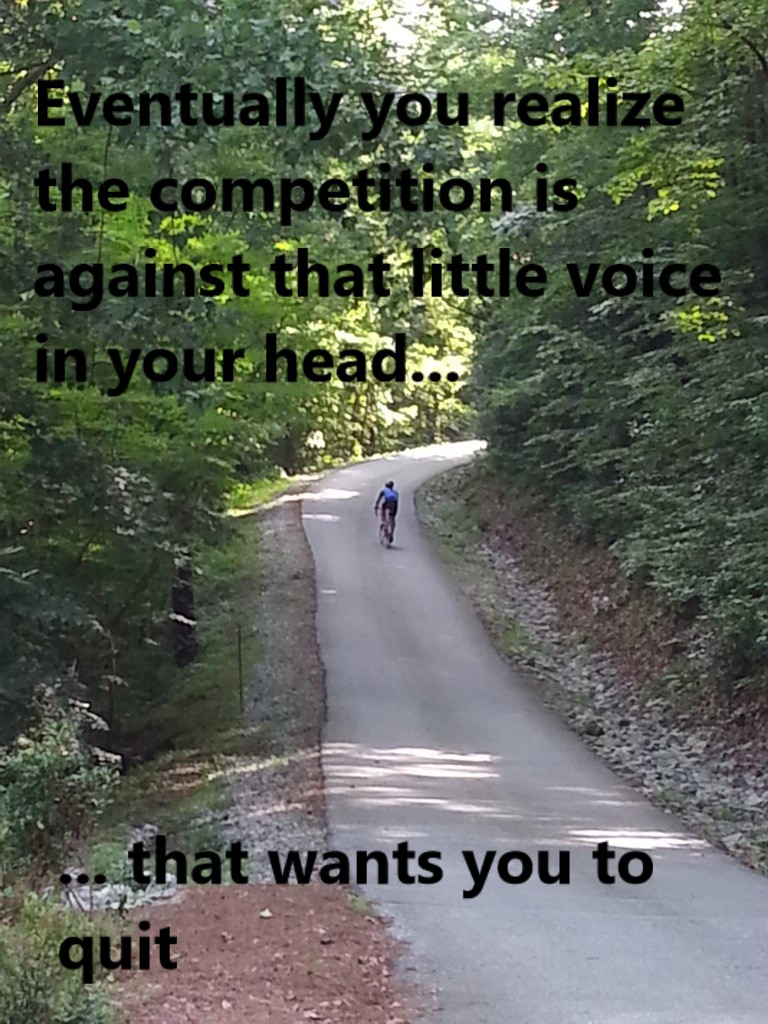We see the pros on TV out front on a breakaway in the Tour de France, their elbows or forearms resting on their handlebar, back parallel to the ground, fast and aero, pounding out the miles…
Yeah, that looks like it hurts, doesn’t it? I can ride pretty low, even at 50, but I’ve got my limits, folks, and I’ll leave all of the yoga required to get power to the pedals in that position to the professionals. In fact, I set my old Cannondale up years ago with a whopping 6″ drop from the nose of the saddle to the handlebar. It looked awesome… and it was so uncomfortable, I lasted less than twenty miles – and I could barely see up the road with my hands on the hoods! In the drops, I had to cock my head to bend my neck that much! The bike was set up like a pro’s bike. Two sizes too small, seat post pegged, stem long and slammed. I did end up with a pro race bike, with affordable components, but set up more reasonably:

Not exactly parallel, but not bad for an old(er) feller, either. My friends, that’s a true, legit, race bike. Pro riders raced that same type of bike in road races the world over. Sure, their frames were S-Works upgrades with Campy Super Record or Dura Ace components, and vastly better wheels… I didn’t have carbon 50’s on mine back then, but a Venge was a Venge, S-Works or not – excepting a hundred grams or so, and a bit of a stiffer (read that harsher) ride. Most important, I’m comfortable riding in the position shown in the photo above.
The difference between a race bike and any other road bike is they’re setup is a little more aggressive, they’re lighter, and faster… that all sounds good to me.
I am 6’0″ and typically ride a 58 cm frame – IF you go by proper sizing. I didn’t want the extra head tube which would raise the cockpit a little higher and have me a little more upright. When I bought my Venge, therefore, I chose one size smaller, a 56. I was offered a 54 in the same bike/colors, just one size smaller, but I was afraid the fit would have been a little too aggressive.

Cool, yes, but that’s a little too much drop for me. That is a 54 cm standard criterium frame, possibly a 53 going by measurements because it’s a compact frame design (notice the short rear triangle). This is why I stuck with the 56 cm Venge over a 54 – I didn’t want to have a bunch of spacers below my stem to keep the handlebar up… I wanted it to look clean once I had the cockpit where I wanted it:

The difference between a 56 and a 58 cm frame is small. Rather than one 5 mm spacer below the stem on my 56, I’d have none. I’d also have ended up with an 80 or 90 mm stem in lieu of the 110 mm stem I have on my 56.
Now, had I wanted to be a little more upright when I rode, I’d have ordered a 58… and a Roubaix, but when I ordered my Venge, it had more to do with lust at first sight than needing another bike, and I wanted to ride it aggressively, or at least, as aggressively as possible for a middle-aged guy.
My Trek, an older race bike, a 58 cm standard frame, was fantastic. That was the driving force for wanting a 56. See, I knew that the compact Venge frame meant it was easier to fit a bigger rider on a smaller bike – swap out a stem and you’re good… without sacrificing power to the pedals.

To get the drop from the saddle to the handlebar on my Trek, to match the Venge, I had to resort to an inverted 17° stem. The goal, though difficult to nail down, was to set up the Trek as close as I could to the Venge, because the Venge fits like a glove. I think I’ve got it as close as is mechanically feasible at this point – there’s nothing left to change – and it’s exceedingly fun to ride now.
So, to wrap this post up, the key factor in picking a race bike that suits your riding style is frame size. If you don’t know what your range is, I would suggest picking your first bike at a local shop. Just be sure to tell them how you plan on riding so they can help you pick the right size. As an example, though, take a 6’0″ tall guy with 33-1/2″ legs, that’s a 58 with a 172.5 mm crank arm for the industry’s idea of my perfect frame size. If I want to ride in a more aggressive position, I go with a 56. A little more relaxed? A 59 or 60.
Having a race bike that works for you is as simple as that, and with modern advances in wheels and tire width, you don’t have to ride 23 mm tires pumped to 120 psi on a ridiculously stiff rig anymore. Put a 25, 26, or 28 mm tire on a race bike and you’ve got a plush, exceedingly fast rig… just make sure, if you buy used, you know if the bike can fit a 25 mm tire in the first place! I ran into quite a bit of trouble on my Trek in that regard.
Race bikes aren’t just for pros. If you’ve got the cash, they’re for anyone who wants to be fast, and that’s all good.

